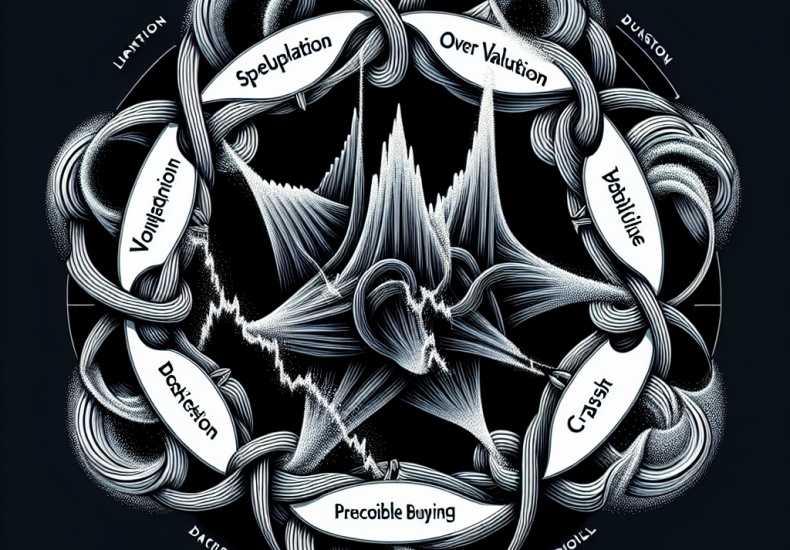
The Life Cycle of Financial Bubbles: Unraveling the Deceptive Dance
During a speculative price increase, a notable trait of financial phenomena is that most participants suspend their disbelief. Unfortunately, the recognition of such events typically occurs only after the bubble pops, a realization that often comes with regret for many investors. Despite this, a few economists have identified a five-phase pattern in the rise and demise of a bubble, which might aid the uninformed in evading its misleading allure.
Within the economic realm, a “bubble” symbolizes a scenario where the value of an asset, whether an individual stock or a broader financial category, far surpasses its original worth. Because speculative demand, rather than intrinsic value, escalates these prices, the bubble is fated to burst. This leads to massive sell-offs that typically cause prices to plummet substantially. Often, the aftermath of a speculative bubble is a staggering collapse in the involved securities.
Bubbles are notorious for their elusiveness and unpredictability. Yet, deciphering the quintet of phases they typically pass through may equip investors to better navigate them. These phases include displacement, boom, euphoria, profit-taking, and panic.
A speculative craze can envelop any asset. Cryptocurrencies like Bitcoin and Dogecoin, meme stocks such as Gamestop and AMC, housing markets, or even tulip bulbs have, at points in history, exhibited inflated values that seemed unsustainable. Four basic categories typically characterize past asset bubbles:
Stock market bubbles center on equities—shares of stocks that experience swift price increases, often misaligned with their companies’ core value (including earnings and assets). These bubbles can encompass the broader stock market, ETFs, or equities within a specific industry—such as the tech boom of the late 1990s.
Asset market bubbles focus on sectors beyond the equities market, like real estate. Currency run-ups, whether in established forms like the US dollar or in digital currencies such as Bitcoin, also fall under this category.
Credit bubbles emerge from a rapid escalation in consumer or business loans, debt instruments, and other credit forms. Assets like corporate or government bonds (e.g., US Treasuries), student loans, or mortgages epitomize this type.
Commodity bubbles arise when traded commodities—tangible materials such as gold, oil, industrial metals, or agricultural products—see sudden price spikes.
The repercussions of a bubble’s burst hinge on its associated economic sectors, the participation spread, and how much debt powered the investments that fueled the bubble.
For instance, the collapse of Japan’s equity and real estate bubbles from 1989 to 1992 resulted in prolonged economic stagnation—so persistent that the 1990s are often labeled a lost decade for Japan. Similarly, the tech bubble’s burst in 2000 and the housing bubble’s implosion in 2008 led to significant recessions.
5. Panic
A seemingly insignificant event can trigger a bubble’s rupture, but once punctured, it cannot reinflate. During the panic stage, asset values plummet as swiftly as they’d soared. Investors and speculators face dire circumstances, leading to bankruptcies and near-collapses of entities like Fannie Mae, Freddie Mac, and AIG. The S&P 500 faced a significant downturn, shedding nearly 17% during one of its worst months.
4. Profit-Taking
In this phase, participants begin to sell off their investments to lock in profits before the bubble bursts. An example: French bank BNP Paribas paused withdrawals from three of its funds heavily exposed to U.S. subprime mortgages, sparking initial market jitters. Although overlooked shortly thereafter as global markets soared, this incident, in hindsight, foreshadowed impending financial turmoil.
Financial bubbles, also known as asset or economic bubbles, fit into four main types: stock market bubbles, market bubbles, credit bubbles, and commodity bubbles. A bubble’s explosive nature can lead to extensive economic consequences.
Fast Fact
The first major financial bubble occurred in 17th-century Holland: Tulip prices skyrocketed unreasonably before collapsing just as swiftly as the tulip petals themselves wilted.
1. Displacement
Displacement arises when investors are captivated by a sudden change. For instance, the interest rate on 30-year fixed-rate mortgages dropped from 6.5% in July 2000 to 1.2% in June 2003. This significant decrease set the stage for the subsequent housing bubble by enticing more investment due to lower borrowing costs.
2. Boom
Following a displacement, a gradual price increase becomes a rapid ascent as speculation intensifies. Escalating prices often surpass justifiable valuations, and the burst of this phase can be sudden. For example, during the late 1990s, tech stocks surged dramatically, with valuations exceeding the GDP of many nations.
Important
“Irrational exuberance serves as the psychological foundation for speculative bubbles,” economist Robert Shiller highlighted in his book “Irrational Exuberance.” He described a bubble as an event where news of price hikes amplifies investor enthusiasm, which spreads through psychological contagion. This contagion intensifies narratives justifying price surges, attracting an ever-expanding group of investors, drawn partly by envy of others’ successes and partly by the thrill of speculation.
A Rosy Start
In the late 1990s, the Internet boom was in full swing, and eToys emerged as a notable player. Its IPO in May 1999 was a significant success: shares initially priced at $20 soared to $78 on their first trading day. Despite being less than three years old, eToys had rapidly increased its sales from $0.7 million in the preceding year to $30 million by March 1999. This marked the displacement phase, as investors were captivated by the shift towards online toy purchasing, seeing it as a dominant trend over traditional retail giants like Toys “R” Us.
Even though eToys reported a net loss of $28.6 million against $30 million in revenue, investor sentiment remained optimistic. By late May, eToys displayed a price/sales valuation far exceeding that of competitor Toys “R” Us, identifying this period as the profit-taking phase. Investors anticipated a turnaround in the company’s financial health despite current losses.
Decline and Fall
By the end of the first quarter of 2000, the panic stage had set in. eToys was spending an unsustainable $2.27 on marketing for every dollar earned in revenue. Despite these expenditures being seen as growth investments by enthusiasts, the ongoing tech stock correction led to the company’s shares trading around $5.
Towards the close of the year, as losses continued to rise, eToys failed to meet its third-quarter sales expectations, with only four months of cash reserves remaining. The stock’s decline was compounded by broader market conditions, ultimately resulting in massive fiscal losses and significant outstanding debt.
“Distinctive bubbles often feature rapid price increases, elevated trading volumes, and word-of-mouth propagation,” notes an Associate Professor of Finance at the Miami Herbert Business School. “If an investment prospect promises outsized returns and emerges through social media or acquaintances, exercise caution. In most scenarios, precise timing is imperative to achieve success.”
Experts like Minsky assert that speculative bubbles in various assets are unavoidable within a free-market system. However, a comprehensive grasp of bubble formation’s stages may assist in spotting future occurrences and avoiding involuntary involvement.
When an asset bubble inevitably bursts, the repercussions can vary greatly. At times, it might only cause short-lived, minor losses. In other instances, it can trigger a major market crash, a broader economic recession, or even a depression. A temporary recovery, dubbed a dead-cat bounce, might occur before a more significant downturn takes hold.
You may also like
Archives
Categories
- Blockchain Technology
- Cryptocurrency
- Cryptocurrency Analysis
- Cryptocurrency Custody
- Cryptocurrency ETFs
- Cryptocurrency Investing
- Cryptocurrency Investments
- Cryptocurrency Payments
- Cryptocurrency Psychology
- Cryptocurrency Regulation
- Cryptocurrency Trading
- Cryptocurrency Trading Platforms
- Cryptography
- Cybersecurity
- Economics
- Healthcare Technology
- Insurance
- Investing
- Real Estate Law
- Retirement Planning
- Technology Supply Chain


